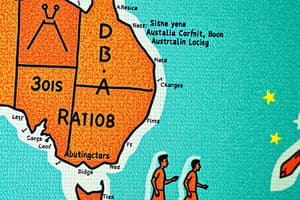Podcast
Questions and Answers
What were some common food items traded among Indigenous communities in Australia?
What were some common food items traded among Indigenous communities in Australia?
- Pizza and hamburgers
- Apples and oranges
- Ice cream and cake
- Durians and rambutans (correct)
Which region was known for its rich supply of tropical fruits like durians and rambutans?
Which region was known for its rich supply of tropical fruits like durians and rambutans?
- Grasslands of Victoria
- Rainforests of north Queensland (correct)
- Deserts of Western Australia
- Mountains of Tasmania
What craft goods were traded from the Flinders Ranges to Western New South Wales?
What craft goods were traded from the Flinders Ranges to Western New South Wales?
- Gold
- Plastic
- Sandstone (correct)
- Marble
Which materials were commonly used to make bone tools traded among Indigenous groups?
Which materials were commonly used to make bone tools traded among Indigenous groups?
What did the Murray River region contribute significantly to food supplies through?
What did the Murray River region contribute significantly to food supplies through?
What was the primary function of kangaroo skins in Indigenous communities?
What was the primary function of kangaroo skins in Indigenous communities?
How did trading networks facilitate relationships among Indigenous tribes?
How did trading networks facilitate relationships among Indigenous tribes?
What was the difference between exchange systems and barter transactions in Indigenous trade practices?
What was the difference between exchange systems and barter transactions in Indigenous trade practices?
How did the arrival of Europeans impact Indigenous trade practices?
How did the arrival of Europeans impact Indigenous trade practices?
What was the significance of shell necklaces and bracelets in Indigenous trade?
What was the significance of shell necklaces and bracelets in Indigenous trade?
Flashcards are hidden until you start studying
Study Notes
Aboriginal Trade
Trade among Indigenous peoples has been a vital aspect of Australian history, with various practices evolving over centuries. This section will outline the types of goods traded, the importance of trade, and how trading networks were established among different Indigenous groups throughout Australia's history.
Types of Goods Traded
The goods exchanged during Aboriginal trade varied from region to region due to the diverse geography and resources available across the country. Some common items traded among Indigenous communities included:
Foodstuffs
Food was an essential component of Aboriginal trade, with groups trading different types of fruits, vegetables, nuts, and seeds depending on their location. For instance, the rainforests of north Queensland were rich in tropical fruit like durians and rambutans, while the deserts offered bush plums and quandongs. The Murray River region contributed significantly to food supplies through bountiful fish harvests.
Craft Goods
Aboriginal craft goods also played a significant role in trade networks, encompassing materials that could be transformed into essential items or utilized for artistic pursuits. Some examples include:
- Sandstone was traded from the Flinders Ranges of South Australia to Western New South Wales for shellfish shells.
- Bone tools, such as spearheads and knives, were exchanged across vast distances.
- Fibre mats derived from plant fibres were exchanged between coastal communities in the northeast of the continent and those located further west.
- Shell necklaces and bracelets made from oyster, pearl, or clam shells were important trade items.
- Kangaroo skins served both practical and decorative purposes, being used as clothing and accessories.
The Importance of Trade
Trade allowed Indigenous peoples to obtain necessities unavailable within their immediate environment or during periods when resources became scarce due to droughts, floods, or other environmental factors. Additionally, trading networks facilitated social interaction, strengthened relationships between neighboring tribes, and reinforced mutual respect among diverse cultural groups.
Establishment of Trading Networks
The establishment of trading networks varied across regions based on geographical features, resource distribution, and proximity to other groups. Generally, trade took place through two primary means: exchange systems and barter transactions:
Exchange Systems
Exchange systems involved the movement of goods from one party to another without any direct payment. In this case, the goods provided might not be equivalent in value but would reflect an understanding of the importance of reciprocal obligations. This arrangement aimed to establish and maintain long-term relationships and alliances between Indigenous groups.
Barter Transactions
In contrast, barter transactions involved direct negotiations between traders, where both parties agreed upon specific goods needed to complete the transaction. These trades typically occurred more frequently and were usually settled immediately after negotiation.
Impact of European Arrival on Indigenous Trade
The arrival of Europeans had significant implications for Indigenous trade practices, leading to new forms of exchange and the loss of traditional trading routes. Due to the introduction of new foods, technologies, and economic systems, many traditional trading practices evolved or ceased entirely. However, some elements of Indigenous trade continue today, demonstrating the resilience and adaptability of these practices over time.
Studying That Suits You
Use AI to generate personalized quizzes and flashcards to suit your learning preferences.




